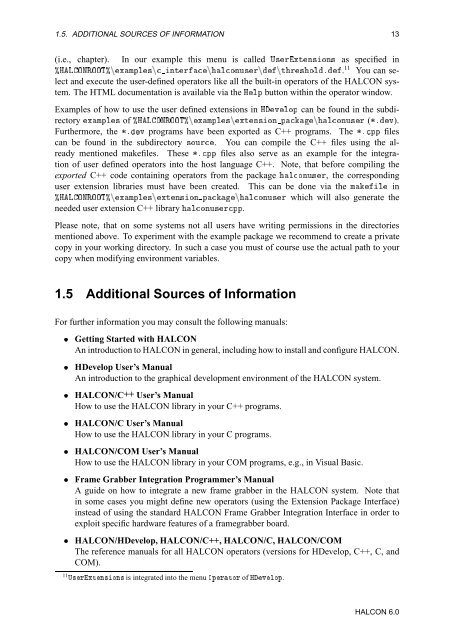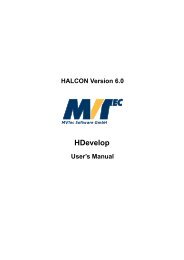HALCON Extension Package Programmer's Manual
HALCON Extension Package Programmer's Manual
HALCON Extension Package Programmer's Manual
- No tags were found...
You also want an ePaper? Increase the reach of your titles
YUMPU automatically turns print PDFs into web optimized ePapers that Google loves.
1.5. ADDITIONAL SOURCES OF INFORMATION 13(i.e., chapter). In our example this menu is called Í×ÖÜØÒ×ÓÒ× as specified in±ÀÄÇÆÊÇÇ̱ÒÜÑÔÐ×Ò ÒØÖÒÐÓÒÙ×ÖÒÒØÖ×Óк. 11 You can selectand execute the user-defined operators like all the built-in operators of the <strong>HALCON</strong> system.The HTML documentation is available via the ÀÐÔ button within the operator window.Examples of how to use the user defined extensions in ÀÚÐÓÔ can be found in the subdirectoryÜÑÔÐ× of ±ÀÄÇÆÊÇÇ̱ÒÜÑÔÐ×ÒÜØÒ×ÓÒ ÔÒÐÓÒÙ×Ö (ºÚ).Furthermore, the ºÚ programs have been exported as C++ programs. The ºÔÔ filescan be found in the subdirectory ×ÓÙÖ. You can compile the C++ files using the alreadymentioned makefiles. These ºÔÔ files also serve as an example for the integrationof user defined operators into the host language C++. Note, that before compiling theexported C++ code containing operators from the package ÐÓÒÙ×Ö, the correspondinguser extension libraries must have been created. This can be done via the ÑÐ in±ÀÄÇÆÊÇÇ̱ÒÜÑÔÐ×ÒÜØÒ×ÓÒ ÔÒÐÓÒÙ×Ö which will also generate theneeded user extension C++ library ÐÓÒÙ×ÖÔÔ.Please note, that on some systems not all users have writing permissions in the directoriesmentioned above. To experiment with the example package we recommend to create a privatecopy in your working directory. In such a case you must of course use the actual path to yourcopy when modifying environment variables.1.5 Additional Sources of InformationFor further information you may consult the following manuals:¯ Getting Started with <strong>HALCON</strong>An introduction to <strong>HALCON</strong> in general, including how to install and configure <strong>HALCON</strong>.¯ HDevelop User’s <strong>Manual</strong>An introduction to the graphical development environment of the <strong>HALCON</strong> system.¯ <strong>HALCON</strong>/C++ User’s <strong>Manual</strong>How to use the <strong>HALCON</strong> library in your C++ programs.¯ <strong>HALCON</strong>/C User’s <strong>Manual</strong>How to use the <strong>HALCON</strong> library in your C programs.¯ <strong>HALCON</strong>/COM User’s <strong>Manual</strong>How to use the <strong>HALCON</strong> library in your COM programs, e.g., in Visual Basic.¯ Frame Grabber Integration Programmer’s <strong>Manual</strong>A guide on how to integrate a new frame grabber in the <strong>HALCON</strong> system. Note thatin some cases you might define new operators (using the <strong>Extension</strong> <strong>Package</strong> Interface)instead of using the standard <strong>HALCON</strong> Frame Grabber Integration Interface in order toexploit specific hardware features of a framegrabber board.¯ <strong>HALCON</strong>/HDevelop, <strong>HALCON</strong>/C++, <strong>HALCON</strong>/C, <strong>HALCON</strong>/COMThe reference manuals for all <strong>HALCON</strong> operators (versions for HDevelop, C++, C, andCOM).11 Í×ÖÜØÒ×ÓÒ× is integrated into the menu ÇÔÖØÓÖ of ÀÚÐÓÔ.<strong>HALCON</strong> 6.0
















